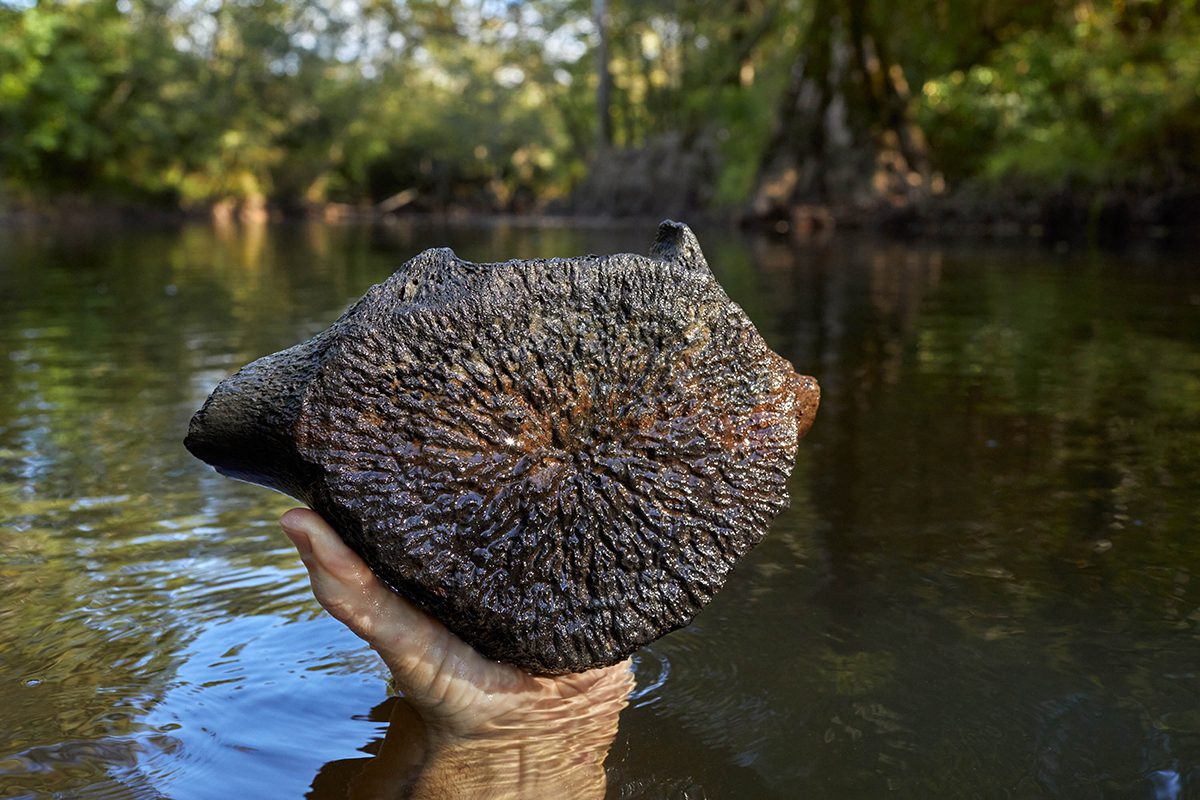
Part of a series for the Pulitzer Center’s nationwide Connected Coastlines reporting initiative that Coastal Review presents in partnership with NC Newsline. The reporting also was made possible with support from the Solutions Journalism Network.
In 2019, an N.C. State Magazine assignment sent me to Princeville, North Carolina, where I met Marquetta Dickens and her cousin, Kendrick Ransome. We stood in the Tar River where their enslaved ancestors were brought ashore and forced to work on plantations in Edgecombe, and I made their portrait. I knew right away I had met some special people in a special place.
Supporter Spotlight

It’s been two years since I published “Tide and Time,” a story about a small cemetery in the village of Salvo on North Carolina’s Outer Banks that was eroding into the sea. The same storms that erode the Outer Banks threaten to erase historic communities 100 miles from the coast. I wanted to learn about that story.
Read “The Whales of Fishing Creek”
“Origins” is a three-part photography and reporting project that explores how climate change is exacerbating Tar River flooding in Princeville — the oldest town in America founded by formerly enslaved Black people. The series investigates Princeville’s ambitious plan to become more climate resilient, as well as natural climate solutions in eastern North Carolina.
Over the past 150 years, Princeville has survived at least eight major floods, including two “500-year” floods in 17 years: Hurricane Floyd in 1999 and Hurricane Matthew in 2016, which caused hundreds of millions of dollars in damage. According to scientists, the town’s neglected, insufficient levee and climate change threaten to cause more frequent and catastrophic flooding and erasure from this marginal land.
The stories explore the origins of climate change born from colonialism and chattel slavery, how Princeville’s floods aren’t natural disasters at all, and how our ecological-climate crisis is interconnected with other justice issues.
Supporter Spotlight
But it’s not enough to report on the symptoms and causes of climate chaos. All of the stories detail climate adaptations and natural solutions, and the ordinary people experimenting with them.
In the NC Newsline stories you’ll meet Princeville Mayor Bobbie Jones, and learn about the town’s ambitious recovery plan and all the obstacles the town faces. You’ll get to know Marquetta Dickens, a local and college basketball standout turned pro, who eventually moved back to Princeville to run a nonprofit to help the town’s recovery. You hear from Ann Adams, who has been displaced from her Princeville home for two years after ReBuild NC delayed its demolition and elevation. Finally, you’ll meet Kendrick Ransome, Marquetta’s cousin, who runs an organic farm near Princeville with his ancestral farming techniques that prevent carbon from escaping into the atmosphere by sequestering it in the soil.
A lot of ink has been spilled about Princeville and I wanted to take readers places they’ve never been before. Photography of climate change is often a pantheon of destruction: starving polar bears, wildfires, and houses crushed by hurricanes. But like in “Tide and Time,” climate change photojournalism should also show us why places are worth saving. It can show us the ordinary people making a difference, as well as daily life and joy, which are true forms of resistance.
Related: Outer Banks ties inform photojournalist’s climate reporting
I also believe that climate change storytelling can do more. I’ve wondered how I can tell a story about solutions while transporting readers across time and space, and expand their imaginations so they can envision other worlds.
Fast forward to 2022 and I’m standing in one of the Tar’s biggest tributaries, Fishing Creek. I’m fossil hunting with Marquetta and my friend Megan. In my muddy hand is a whale vertebrae the size of my head that I dislodged from the creek bottom. I looked up and in my mind I could see the whales swimming over the tree line.

This final chapter takes us to the prehistoric past, to the Pliocene Epoch, 3 million years ago, when the Atlantic Ocean covered the coastal plain and prehistoric whales swam over Princeville. When the old whales died, their bones settled in the ancient seafloor and fossilized over millions of years. The same intense storms that cause the Tar River to flood Princeville erode these fossils from the creek and river bottoms, revealing the remains of this ancient marine world.
Current atmospheric carbon levels are around 421 parts per million — higher than they’ve been in about 3.6 to 4.5 million years, when temperatures were 3 to 4 degrees Celsius (5.4-7.2 degrees Fahrenheit) warmer and sea levels were 70 to 80 feet higher. According to the International Panel on Climate Changes, temperatures are on track to climb to nearly 3.2 degrees Celsius, to Pliocene temperatures — or higher — beyond 2100, without immediate climate action.
The whale fossils buried under Princeville reveal what prehistoric climates can tell us about our future, what whales can teach us about natural marine climate solutions, and about how the fates of Black people and whales are an interconnected justice issue. The spirits of these prehistoric whales still inhabit the landscape of eastern North Carolina. They have something to teach us about climate resilience and solutions, and about ourselves: We are of the land, we are of the deep past.
With this Pulitzer Center Connected Coastlines grant, I wanted readers to reimagine human geographic boundaries, connect the coast with the coastal plain, and to never see the eastern North Carolina landscape the same way again. The next time you drive down U.S. 64, or N.C. 33, look out over the cotton fields and imagine the whales.
Explore the rest of the series
Homecoming Part I
A Black town in a floodplain persists and forges its own future despite unnatural disasters, policy failures, and white supremacy.
Homecoming Part II
Can Princeville’s recovery plan succeed despite obstacles? A resident displaced by flooding fights to return home to Princeville.
The Soil Farmers
Black farmers heal the soil, fight climate change and provide healthy food to their rural communities.
Note: “The Whales of Fishing Creek” is not available for reprint.







